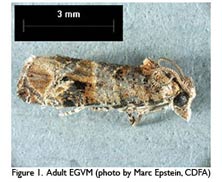European Grapevine Moth Pest Profile


- Common Name:
European Grapevine Moth (EGVM) - Scientific Name:
Lobesia botrana (Denis & Schiffermüller) - Order and Family:
Lepidoptera: Tortricidae
Adults are small, nocturnal moths approximately 6-8 mm long (1/4”), with a wingspan of 11-13 mm (1/2”); the wings are held in a bell shape over the abdomen when at rest. The forewings are tan to cream in color, mottled with gray-blue, brown, and black blotches, while the hindwings are gray with a fringed border (Figure 1). Eggs are flattened and elliptical, and are laid singly or, more rarely, in groups of two or three. Mature larvae reach a length of 12-15 mm (1/2”), with the body color varying from light green to light brown depending principally on larval food. The pupae are brown, 4-9 mm long, and encased in a thin whitish silken cocoon.
EGVM larvae preferentially feed on grape flowers and fruit, olive flowers, and flowers, fruit, and new growth of its presumed original host, spurge laurel. However, it will also feed on the flowers and/or fruit of a variety of other plants such as blackberry, carnation, cherry, currant, gooseberry, ivy, kiwifruit, nectarine, persimmon, plum, pomegranate and privet.
In Europe, this moth typically undergoes three generations per year. EGVM adults emerge in the spring and lay eggs primarily near host flowers. In Europe, first generation larvae occur in May and June and feed on flower clusters. Second generation larvae occur in July-August and feed on green berries. Young larvae penetrate the berry and hollow them out, leaving the skin and seeds. Third generation larvae occur in August-September and cause the greatest damage by webbing and feeding inside berries and within bunches, which become contaminated with frass. Feeding damage to berries also exposes them to infection by Botrytis and other secondary fungi. Pupation during the spring and summer occurs inside a thin cocoon usually within a rolled up leaf, whereas larvae from the last generation of the year pupate in more protected places, such as under bark, in soil crevices, or in leaf litter. EGVM overwinters as a diapausing pupa.
European grapevine moth is primarily a pest of economic importance to grapes, which is the number one agricultural plant commodity grown in California with an annual gross production value of $3.9 billion (USDA NASS 2009). Based on its status as a significant grape pest in other parts of the world, permanent establishment of EGVM in California would result in significant production and export issues for grapes. Establishment could also result in a lesser export issue for some of EGVM’s other fresh market agricultural and nursery host plants.
Literature Cited:
USDA NASS. 2009. California County Agricultural Commissioners’ Data, 2008. United States Department of Agriculture. National Agricultural Statistics Service. California Field Office, Sacramento. 76 pp.

